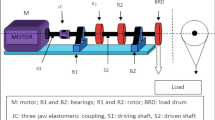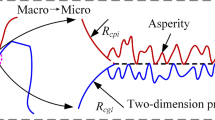Abstract
Gear flank twist has a significant effect on the load-carrying capacity. However, most prediction models of gear flank twist cannot be applicable for gears with profile modification. A new method for predicting gear flank twist for the generating grinding process is developed in this paper, taking into consideration the effect of lead modifications, profile modifications, and position errors of CNC machine tools on gear flank twist. And the influences of four gear parameters on gear flank twist were studied using orthogonal experiments, which prove that the change of module has the greatest effect on gear flank twist. And the maximal profile modification value has minimal effect on gear flank twist. The experimental results proved that the model can accurately predict the gear flank twist. Besides, this paper described a gear parameter optimization study to reduce gear flank twist based on nine well-planned orthogonal experiments.








Similar content being viewed by others
Data availability
The authors have no financial or proprietary interests in any data and material discussed in this article.
Code availability
The authors have no financial or proprietary interests in any code discussed in this article.
References
Kruszinski BW (1995) Model of gear-grinding process. Annals of the CIRP 44:321–324. https://doi.org/10.1016/S0007-8506(07)62334-8
Yu B, Shi ZY, Lin JC (2017) Topology modification method based on external tooth-skipped gear honing. Int J Adv Manuf Technol 92:4561–4570. https://doi.org/10.1007/s00170-017-0463-2
Liu PX (2017) Study on design method of topological modified gear considering continuous generation gear grinding process. Dissertation, Chongqing University (in Chinese)
Tian X, Zhou L, Han J, Xia L (2021) Research on gear flank twist compensation of continuous generating grinding gear based on flexible electronic gearbox. IEEE Access 9: 151080–151088. https://doi.org/10.1109/ACCESS.2021.3126673
Tran VT, Hsu RH, Tsay CB (2014) Study on the anti-twist helical gear tooth flank with longitudinal tooth crowning. J Mech Des 136:061007. https://doi.org/10.1115/1.4027166
Shih YP, Chen SD (2012) A flank correction methodology for a five-axis CNC gear profile grinding machine. Mech Mach Theory 47:31–45. https://doi.org/10.1016/j.mechmachtheory.2011.08.009
Fong ZH, Chen GH (2016) Gear flank modification using a variable lead grinding worm method on a computer numerical control gear grinding machine. J Mech Des 138:083302. https://doi.org/10.1115/1.4033919
Hsu RH, Su HH (2014) Tooth contact analysis for helical gear pairs generated by a modified hob with variable tooth thickness. Mech Mach Theory 71:40–51. https://doi.org/10.1016/j.mechmachtheory.2013.09.001
Jiang WJ, Wei J (2013) Influence of tooth errors and truing principles of grinding wheel abrasion for machining arc enveloping worm. Adv Mater Res 652:2153–2158. https://doi.org/10.4028/www.scientific.net/AMR.652-654.2153
Vedmar L (2010) A parametric analysis of the gear surface roughness after hobbing. J Mech Des 132:111004. https://doi.org/10.1115/1.4002655
Chen HF, Tang JY, Zhou WH, Chen CS (2017) The equal theoretical surface roughness grinding method for gear generating grinding. Int J Adv Manuf Technol 90: 3137–3146. https://doi.org/10.1007/s00170-016-9651-8
Zhou WH, Tang JY, Chen HF, Shao W, Zhao B (2019) Modeling of tooth surface topography in continuous generating grinding based on measured topography of grinding worm. Mech Mach Theory 131: 189–203. https://doi.org/10.1016/j.mechmachtheory.2018.10.001
Yan PH, Li T, Kou ZD, Yu GY, Zhao HH (2021) Research and application of calculation method of gear flank twist by generating gear grinding. Tool Engineering 55:77–81 ((in Chinese))
Yu B, Kou H, Zhao B, Sun YQ, Wu GQ (2021) Approximation model for longitudinal-crowned involute helical gears with flank twist in continuous generating grinding. Int J Adv Manufac Technol 114:3675–3694. https://doi.org/10.1007/s00170-021-07099-y
Wu XT (2009) Theory of gear meshing. Xi’an Jiaotong University, Xian, Shanxi
Funding
This work was supported by the Key Technology Research and Development Program of Shandong Province (Grant numbers [2019JZZY010114]). Authors Jun Zhao and Zijian Zhang have received research support from the China National Heavy Duty Truck Group.
Author information
Authors and Affiliations
Corresponding author
Ethics declarations
Consent to participate
All authors consent to participate in the study.
Consent for publication
All authors consent to the publication of this article.
Competing interests
The authors declare no competing interests.
Additional information
Publisher's Note
Springer Nature remains neutral with regard to jurisdictional claims in published maps and institutional affiliations.
Rights and permissions
About this article
Cite this article
Zhang, Z., Zhao, J., Pan, S. et al. Modeling and prediction of gear flank twist for generating gear grinding. Int J Adv Manuf Technol 121, 6751–6761 (2022). https://doi.org/10.1007/s00170-022-09765-1
Received:
Accepted:
Published:
Issue Date:
DOI: https://doi.org/10.1007/s00170-022-09765-1




